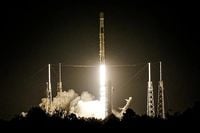Space has never been busier, nor more consequential, than it is right now. As October 2025 unfolds, a flurry of launches, discoveries, and strategic deals is reshaping how nations, companies, and scientists approach the final frontier. From record-setting rocket flights to tantalizing clues about life beyond Earth, the past week has offered a vivid snapshot of the new space age—one marked by competition, collaboration, and a steady blurring of lines between science, security, and commerce.
On October 3, 2025, SpaceX notched its 125th Falcon 9 launch of the year, sending 28 Starlink internet satellites into orbit from California’s Vandenberg Space Force Base. According to Space.com, the booster—serial B1097—landed safely on the Of Course I Still Love You droneship just eight minutes after liftoff, marking its second successful flight. This relentless launch tempo is no fluke: more than 70% of SpaceX’s launches in 2025 have been for Starlink, the company’s ever-expanding broadband constellation. With over 8,500 active Starlink satellites now circling the globe, Starlink alone accounts for about two-thirds of all operational satellites worldwide—a staggering figure that underscores SpaceX’s dominance in low-Earth orbit communications.
But SpaceX isn’t just busy launching satellites. The company is also gearing up for the second test flight of its Starship mega-rocket, now targeting October 13. After an explosive first attempt in April, SpaceX made upgrades and secured FAA clearance, aiming to finally reach orbit with a fully reusable vehicle designed for Mars missions. If successful, this flight could open a new era of super-heavy, fully reusable launchers—potentially slashing the cost of space access and enabling ambitions as grand as Moon bases and Martian cities.
Meanwhile, the U.S. government is doubling down on its own space priorities. On October 3, the U.S. Space Force and the National Reconnaissance Office announced $1.142 billion in new national security launch contracts. As reported by Spaceflight Now, SpaceX was awarded five missions worth $714 million—including four Falcon Heavy launches and one Falcon 9 mission—while United Launch Alliance (ULA) received two missions valued at $428 million, both to be flown on their Vulcan rocket. These launches, scheduled no earlier than fiscal year 2027, will loft a mix of classified payloads and known satellites, such as the Wideband Global SATCOM (WGS-12) and the latest GPS III Follow-on (GPS IIIF) spacecraft.
Blue Origin, Jeff Bezos’s space firm, is also making headlines. The company is preparing for the second launch of its heavy-lift New Glenn rocket in mid-October, carrying NASA’s twin ESCAPADE probes to Mars orbit—a high-profile, $80 million mission that will test New Glenn’s interplanetary chops and attempt its first booster recovery. Earlier this month, Blue Origin also announced the passenger lineup for its next New Shepard suborbital tourism flight, NS-36, featuring five named private individuals and one who opted to remain anonymous. With the commercial space tourism sector heating up, Blue Origin’s 15th crewed mission will further cement the company’s role in making space accessible—at least for those who can afford the ticket.
Rocket Lab, another key player in the small-launch market, grabbed industry headlines by signing a 10-launch contract with Japanese firm Synspective to loft radar imaging satellites. This deal, announced October 3, marks Rocket Lab’s largest-ever single customer order and signals robust demand for dedicated smallsat launches. The company is also developing a larger Neutron rocket for 2026, aiming to compete in the booming market for medium-lift missions.
The international space scene is equally dynamic. The European Space Agency (ESA) deepened its ties with Asia by signing a cooperation pact with South Korea’s KASA, enabling shared tracking networks and joint missions in science and exploration. ESA also announced a rideshare mission with Japan’s JAXA: Europe’s Ramses probe will launch alongside JAXA’s Destiny+ spacecraft to study asteroid Apophis ahead of its 2029 Earth flyby. ESA’s Director General Josef Aschbacher called it “an important moment for Europe and Korea, opening up great opportunities… and strengthening our cooperation,” according to Space.com.
Security is also top of mind. The UK Space Command is investing £500,000 in sensors to protect satellites from laser attacks, responding to what it calls “increasing hostile activity in space.” As General Paul Tedman, head of UK Space Command, put it, without their space assets, Western militaries “can’t effectively understand, move, communicate, and fight.” Germany has committed €35 billion over five years to space security, while France has invested €1.5 billion in satellite operator Eutelsat to challenge the dominance of constellations like Starlink.
Amid all this activity, science continues to deliver awe-inspiring results. NASA’s Perseverance rover made a splash with its discovery of an organics-rich Mars rock, dubbed “Cheyava Falls.” The rock contains minerals such as vivianite and greigite—on Earth, these often form via life-related chemical reactions. As Dr. Mike Tice, a geobiologist on the team, explained to Space.com, “All living things need to get energy from their environment. Life on Earth figured out how to do that very early by taking advantage of redox reactions.” While the discovery is “very indirect evidence for life” and not proof of ancient Martians, it is precisely the kind of tantalizing clue astrobiologists have been seeking. Perseverance has cached samples of the rock, which could someday be returned to Earth for definitive analysis.
Farther afield, Saturn’s moon Enceladus is back in the spotlight. Scientists reanalyzing data from NASA’s Cassini probe found new complex organic molecules in the icy plumes erupting from the moon’s subsurface ocean. According to Reuters, these organics are precursors to amino acids, and their discovery bolsters the case for Enceladus’s potential habitability. “A fresh look at data… has uncovered more evidence that Enceladus may be able to support life,” said lead author Nozair Khawaja. While no direct biosignatures were found, the detection of these building blocks strengthens the argument that Enceladus harbors the necessary ingredients for life as we know it.
The commercial vision for space’s future is equally ambitious. Speaking in Italy, Jeff Bezos predicted that “gigawatt-scale data centres” powered by 24/7 solar energy could be operating in orbit within 10 to 20 years. “We will be able to beat the cost of terrestrial data centres in space in the next couple of decades,” he said, framing orbital infrastructure as the next logical step after communications satellites.
Meanwhile, China’s space sector continues its rapid ascent. Although there were no major Chinese launches this week, commercial startups like Space Pioneer and LandSpace have demonstrated new methane-fueled rockets and vertical landing technology, aiming to close the gap with SpaceX’s reusability advances. The race is clearly on, with new players and established giants alike pushing the boundaries of what’s possible.
As World Space Week 2025 celebrates the theme “Living and Working Beyond Earth,” the convergence of science, security, and commerce is more apparent than ever. From Mars rocks to mega-constellations, and from international alliances to the dreams of orbital data centers, this is a moment of profound transformation. The story of space is no longer a distant dream—it’s happening now, above us, every day.

